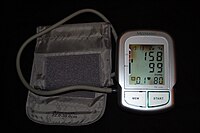
Photo from wikipedia
See related article, pp 211–219 In this issue, an article by Banegas et al entitled “Clinic Versus Daytime Ambulatory Blood Pressure Difference in Hypertensive Patients: The Impact of Age and… Click to show full abstract
See related article, pp 211–219 In this issue, an article by Banegas et al entitled “Clinic Versus Daytime Ambulatory Blood Pressure Difference in Hypertensive Patients: The Impact of Age and Clinic Blood Pressure” emphasizes, once again, the folly of relying on clinic blood pressure (BP) to guide diagnostic and management decisions in clinical practice.1 However, apart from the reported findings, the article carries what may be a more profound message, namely, the value of BP registries: first, in directing practice and second, in indicating to healthcare providers the most appropriate apportionment of resources or put more bluntly, how best to spend money. But first, the study findings. It is accepted that clinic BP is usually higher than daytime ambulatory BP in hypertensive patients, but it has been suggested that age may influence this assumption. Data derived from the Spanish ambulatory blood pressure monitoring (ABPM) Registry (discussed further below) in >100 000 adults enrolled from usual primary care practice, with hypertension defined by an office BP ≥140/90 mm Hg showed that mean clinic values were higher than daytime BP in most patients at all ages, irrespective of treatment status.1 Moreover, white coat hypertension was especially common (50%) in patients with grade I hypertension according to clinic BP, and masked hypertension was commonest (23%) in patients with borderline hypertension. The message is clear on 2 sides of the revelatory coin of measurement: first, on the white coat side, if doctors continue to rely on clinic BP to diagnose hypertension, then they will overdiagnose the illness, inappropriately classify hypertension as being more severe than it actually is, and consequently overtreat patients, and for those patients on treatment, reliance on clinic BP will substantially underestimate the number of patients who are well controlled, leading once again to excessive treatment. Second, on the masked …
Journal Title: Hypertension
Year Published: 2017
Link to full text (if available)
Share on Social Media: Sign Up to like & get
recommendations!